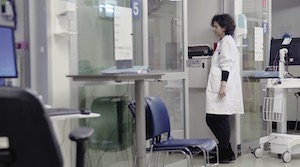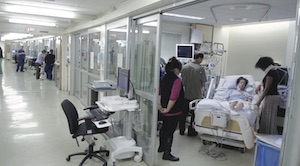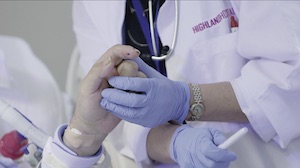FEATURES
A Better Death
One physician's mission to remove patients from the 'end-of-life conveyor belt'
 PHOTO: Dan Krauss, Courtesy of Netflix
PHOTO: Dan Krauss, Courtesy of NetflixJessica Nutik Zitter is featured in Extremis, an emotional, unflinching and Oscar-nominated short documentary about end-of-life care directed and produced by Dan Krauss. Photos are from the film and courtesy of Netflix.
Jessica Nutik Zitter, MD (MED '92), stared down at her patient lying under sterile drapes. The woman's breast cancer had metastasized, her kidneys were failing, her liver was shutting down and her blood pressure was tanking. She had been in the hospital for weeks, and there was no way to avoid the truth: She was dying.
Instead of breaking that news to the woman's husband, Zitter said she needed to start dialysis. Privately, the intensive-care unit (ICU) physician doubted this decision. Her patient was going to die, and she feared the procedure would only increase the woman's suffering. But Zitter had always wanted to save lives and this was how she believed you did it—go for broke, even in the face of defeat.
Medical students surrounded Zitter as she prepared to insert the dialysis catheter. But then she noticed someone hovering in the doorway.
It was Pat Murphy, an advanced-practice nurse and leader of the family support team. Comprising nurses, social workers and counselors, the team was attempting to bring palliative care techniques—improved quality of life and better communication and pain management—to the ICU.
Murphy looked furious. Before Zitter could speak, Murphy mimed holding a telephone to her ear. "911, get me the police," she said. "They're torturing a patient in the ICU."
It was 2003, and Zitter, a young physician at University Hospital in Newark, New Jersey, couldn't have known how profoundly that moment would change her life—how it would lead her to write a book, be featured in an Oscar-nominated documentary and make her one of the nation's most prominent advocates for improving how Americans die. In the moment, all Zitter felt was humiliation and anger. All she thought was that she had only one choice: insert the catheter.
She did, but it didn't matter. The patient died the next day.
ACCIDENTAL EVANGELIST
Zitter's nearly three decades of practicing medicine have led to this conclusion: America is in the throes of a public-health crisis of bad deaths. She has seen too many patients die far from the places and people they held dearest, unable to express their wishes, plugged into a ventilator, tied to their beds so they wouldn't accidentally dislodge the tubes that sprouted from their bodies like vines. They died despite her best efforts to keep them alive, and she feared that those best efforts even sometimes led to worse deaths.
"I have a front-row seat to this every day, and you can't not be moved to act," said Zitter, an attending physician in critical care and palliative medicine at Highland Hospital in Oakland, California. These bad deaths were occurring because most patients knew too little about their conditions, she said, and most physicians lacked clarity about their patients' wishes—what Zitter deems an enormous injustice.
Raised to believe in doctoring as social justice, she feels duty-bound to try to right that wrong. That's why she transformed from a clinician who kept people alive at all costs to a self-labeled "accidental evangelist" for bettering how people die and eliminating the "end-of-life conveyor belt"—her term for the unquestioning use of technology, treatment and intervention to keep a patient alive, regardless of the quality of life.
To spread the word, Zitter speaks out, crisscrossing the country and writing for national publications. She's also educating the next generation—whether the teenagers at her younger daughter's high school who take her "death education class" or hospital residents who need to hear that it's normal to grapple with the trauma they witness, to wonder if they made the right decision in a particular case.
"She's one of the ones who is brave enough to say what we're all thinking on the inside," said Lannie Santo, MD, a third-year internal-medicine resident at Kaiser Permanente in Oakland who plans to go into palliative care.
But the bravery and candor remain a struggle. While a growing number of physicians and patients share Zitter's views, she still experiences pushback from others—and even self-doubt in certain cases.
In 2012, after she'd been integrating patient-centered and critical-care medicine for nearly a decade, she cared for a woman with lung cancer. Following aggressive treatment in the ICU, the woman stabilized and told Zitter she was ready for more chemotherapy. Zitter was shocked—to her, it was clear this woman was dying.
The patient, however, didn't know it and didn't want to hear it. "There was a sign in the [hospital] room that said, 'No bad news,' "Zitter said. She agonized over whether to be truthful with the woman and her family. Eventually, honesty won out.
Zitter held the patient's hand and slowly, gently, began to talk about options—treatments to manage the symptoms; ways to make the woman's remaining days as good as possible. The mood at first was som- ber, but then angry family members ordered Zitter to leave.
She later returned filled with trepidation. Had she done right by her patient by being honest—or made this woman's dying days more painful? She was astonished by what she found. The patient was sitting up in bed, perky, video-chatting with her daughter who was at home setting up a hospital bed in the living room. The woman had opted for hospice care to pursue comfort over fruitless treatments. She lived another two months—time filled with her favorite wine, games of Scrabble, cuddles with her grandkids—and died at home. "I say she chose cabernet over chemo," Zitter said, beaming. "And she had a beautiful, beautiful final two months."
If only she could have told that story to the young resident she once was.
 PHOTO: Dan Krauss, Courtesy of Netflix
PHOTO: Dan Krauss, Courtesy of NetflixJessica Zitter is on a mission to spread the idea of patient-centered care, which she believes is key to giving Americans better deaths.
MORAL DISTRESS
Zitter was born in Montreal, into a family of physicians. Her grandfather, uncles and father, Stephen Nutik, practiced medicine, and her mother, Rhoda Nutik, MD (MED '94), became a physician two years after Zitter.
Grandfather Nutik's clinic, which he ran from the first floor of his home, operated on a steep, sliding fee scale, even sometimes treating patients for free. "That was something that really resonated with me," said Zitter, who also earned a master's degree in public health and has spent her career in hospitals that primarily serve low-income patients.
After earning an undergraduate degree at Stanford University, Zitter came to Case Western Reserve University's School of Medicine in 1988, drawn in part by reports of its innovative curriculum, which used real-world scenarios to teach students.
The school's patient-first approach spoke to her. But as Zitter advanced to a residency in internal medicine at Brigham and Women's Hospital in Boston and then a fellowship in pulmonary and critical care at the University of California, San Francisco, she felt drawn farther away from holistic care and deeper into the specialized, high-octane world of critical care, "thinking that what it meant to pursue justice was really to be scooping people out of the jaws of death," she said.
Yet, from when she first performed bone-cracking chest compressions on a patient who clearly was not coming back, she began to feel moral distress. "I started to perceive that there was a tremendous amount of suffering that I was witnessing and, frankly, that I was contributing to," she said. "I thought, 'Get used to it, this is part of the business of saving lives.'"
But she couldn't. So in 2003, when Murphy accused Zitter of torturing a patient, it shook her to her core.
A DIFFERENT WAY
Palliative medicine, which focuses on enhancing communication, managing symptoms and improving quality of life for people with life-limiting illnesses, slowly gained traction over several decades. A critical turning point in its acceptance came with the 1995 publication of a five-site study that took a hard look at how Americans died—and whether they were getting care consistent with their wishes. Alfred F. Connors, MD, a Case Western Reserve professor of medicine, was a principal investigator leading the university research team at MetroHealth Medical Center in Cleveland.
Formally known as the Study to Understand Prognoses and Preferences for Outcomes and Risks of Treatments, or SUPPORT, it followed 9,000 severely ill people for six months, during which nearly half died. The study revealed, among other things, that physicians often didn't understand their patients' end-of-life care preferences. As a result, patients often died in intensive-care units, isolated from their families, on machines and in pain. "Clearly, this was not the way most of us want to die," said Connors, who served as chair of the Department of Medicine and chief medical officer at The MetroHealth System before retiring last year. "This study led to a national effort to change the way we care for patients at the end of life."
As a fourth-year medical student, Zitter trained with Connors in the MetroHealth ICU while the SUPPORT study was ongoing.
She learned about it in the early 2000s, when she was already back on the road to patient-centered care—a radical change in perspective fueled by Murphy's bedside confrontation. The deeper she's gone into the world of patient-centered care, the more she sees how urgently it is needed. "People don't know what's happening to them," she said, leaning forward, eyes blazing. "That is an injustice that has to change."
 PHOTO: Dan Krauss, Courtesy of Netflix
PHOTO: Dan Krauss, Courtesy of Netflix"My two biggest mentors as a doctor are a nurse and a chaplain," said Jessica Zitter, who learned to talk honestly to dying patients about their diagnosis and recognize their spiritual suffering.
LEARNING AND GROWTH
"Here's some context for you about me," said Zitter, who by her own accounts grew up idolizing "strong and silent" surgeons: "My two biggest mentors as a doctor are a nurse and a chaplain."
Of course, the nurse she speaks of is Murphy, PhD, who has cared for dying patients in many settings for more than 30 years. After their confrontation, which "shocked my whole system," Zitter sought out Murphy.
"She was thirsty to learn about how to care for patients in a different way," Murphy said. With Murphy's guidance, Zitter became board certified in palliative care and learned to carry herself in a way that bucks the stereotype of a commanding ICU physician—by showing strength yet embracing humility, honesty, vulnerability and the idea that she doesn't always have the answers. Santo, one of the many residents Zitter mentors, said this demeanor "is really empowering to younger doctors because that's not modeled."
Zitter also credits the Rev. Betty Clark, who works at Highland Hospital as part of the palliative team, for helping her "come back to that human-centered approach" time and again.
Zitter is Jewish and understands the role faith plays in end-of-life situations, but she long felt as if it wasn't her place to pray with patients. About a year ago, she visited a patient and found Clark at the bedside. "I was getting ready to leave the room, which is what I typically would do," Zitter said, "and [Clark is] like, 'No, why don't you stay and pray with us.' " It proved transformative for Zitter. She learned how deeply some patients need their physician to acknowledge their spiritual suffering; how prayer can be a critical building block for trust.
LOOMING CHANGE
Zitter opens her 2017 book, Extreme Measures, with a declaration: "I didn't set out to change the culture of medicine, my chosen and beloved profession. I just found I had no choice but to try."
And try she does, through her speeches, writing, community engagement, mentoring and the short documentary Extremis. The book frankly chronicles the immense suffering she's seen in critical care, reflects on her own shortcomings and offers suggestions for how to move toward better deaths. Extremis, directed and produced by Dan Krauss and nominated for a 2017 Academy Award, raises the same questions about what makes for a good death.
Although much of Zitter's national work focuses on public education, she's also uniquely positioned to reach her peers, said Dawn Gross, MD, PhD, an attending physician in palliative care in San Francisco. Zitter's dual specialties in critical care and palliative care make her a rarity, Gross said, and give her the credibility to "advocate for the importance of palliative-care medicine" in the ICU in a way colleagues are more likely to welcome.
Zitter also is confident the nation is on the cusp of sweeping change. She's found that when patients understand the realities of life permanently attached to a ventilator or feeding tube, most choose to die naturally. She's heartened by the growing movement of people pushing for improved communication, stronger relationships between physicians and patients, and better ends of life. And when she encounters resistance from colleagues, has patients who seem unwilling to face the truth, or her courage falters, she hears Murphy whispering in her ear: "Step into that difficult conversation. It's not going to be pretty, but you have to do it, and it's going to be OK."
SIX KEYS TO A BETTER DEATH
Jessica Nutik Zitter's book, Extreme Measures, includes an appendix to help readers think through and plan for what type of end-of-life care they would like to receive. Here are six key takeaways:
1 Determine your health status: Are you young and healthy, older and healthy, chronically ill, grappling with a serious diagnosis or near death? Your status might change your end-of-life care preferences.
2 Know your trajectory: Understanding the way your condition or disease typically progresses can help you think through the type of care you may need in the future.
3 Talk to your doctor: "You might need to directly ask for the truth for your doctor to give it to you," Zitter wrote. Having a full and clear picture of your diagnosis, such as what you can expect if you do—or don't—pursue possible treatments, is key to decision-making.
4 Explore your priorities: Identifying what quality of life matters to you—maintaining independence, being pain free, being alert, holding on to every second, regardless of your condition—will help you zero in on how you want to be treated at the end.
5 Decide if you want to plug in: If a range of options exists, with one end being "keep me alive at all costs" and the other being "keep me comfortable and allow me to die naturally," what's your preference?
6 Speak up: Communicate your wishes to your family and physician, but also consider creating an advance directive, a do-not-resuscitate order or a physician order for life-sustaining treatment, known as a POLST.

To learn more about Jessica Nutik Zitter, her work and her book, Extreme Measures, visit jessicazitter.com





